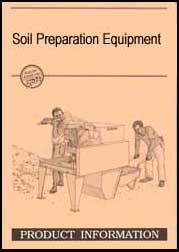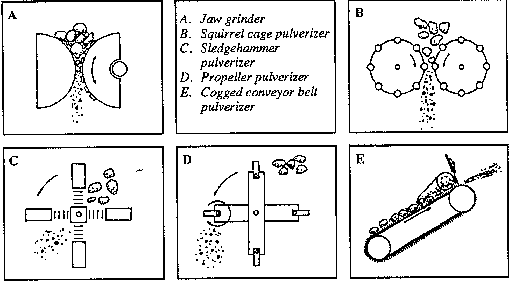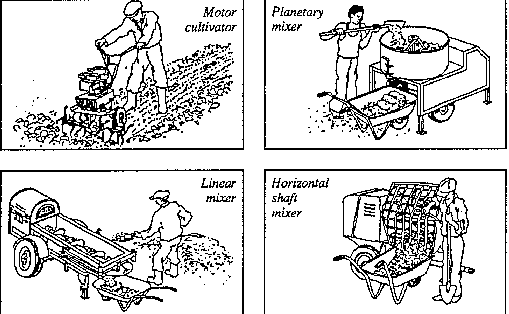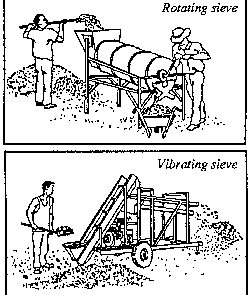
Equipment[edit | edit source]
Traditional earth construction techniques are generally associated with manual operations and simple, locally made tools. Today, a variety of equipment is available for the preparation of soil for building construction, reducing the necessary manual operations to a minimum, greatly increasing the output rates and considerably improving the quality of the material and final product. Some of the main types of equipment are described below.
Excavation Equipment
If an entrepreneur contemplates the use of more sophisticated equipment than shovels and wheelbarrows for excavation, a variety of special tools and machines can be used, depending on several factors, such as:
- the area and depth of excavation,
- the required output,
- the characteristies of the site, that is, its angle of slope, its accessibility, the kind and amount of vegetation on it, the quality of the soil, etc,
- safety considerations, and
- the availability of skilled manpower.
Typical excavation tools, which are mainly used in quarries, road building, agriculture, landscaping, etc, are, for instance, pneumatic picks, motorized wheelbarrows, scrapers, excavator tractors, bulldozers, and the like. However, their use for earth construction in a developing country is most likely to be very limited, on account of the high capital and operating costs, import restrictions, problems of maintenance and repair, and other limiting factors.
Laboratory Equipment for Control Tests
It is not possible to describe all the equipment that can be used for soil testing and quality control, as they are too numerous and some are very specialized. Therefore, only a few of the most common devices are described below:
Grain size distribution
The sieving test consists of passing the soil through a series of standardized sieves with the help of water, and after drying, observing the grain fractions retained by each sieve. This fraction will be expressed in percentage by weight compared to the dry initial sample. The equipment required for this test is:
- a rubber pestle end mortar of 500 ml capacity for preliminary disintegration;
- 4 standard soil test sieves (ASTM, AFNOR or DIN) of 100 or 200 mm diameter;
- at least 2 metal mixing pans for collecting the material in the sieves and drying on
- a butane field stove (hot air laboratory stoves are too slow);
- a resistant sieve brush and a plastic 200 ml dispensing bottle;
- a field balance of minimum 1 kg capacity and a precision of 1 gram.
A soil texture kit is recommended to separate the soil into its 3 basic mineral fractions (sand, silt and clay) and to determine the approximate percentages. The test is not recommended for soils containing a lot of gravel and the sample has to be dry before use. The kit includes 3 calibrated conical tubes, stand as well as dispersing and flocculating reagents.
The sand equivalent test is intended to indicate the relative proportions of clay-like or plastic fines and dusts in granular soils and fine aggregates that pass the 5 mm sieve. The kit should comprise at least 2 sand equivalent cylinders with rubber stoppers, 1 measuring can, 1 bottle of stock solution, 1 weighted foot assembly, a wide mouth plastic funnel, a syphon assembly with 5 litre polythene bottle and an irrigation tube. A sand equivalent shaker is also needed and can be electric or hand operated. All these tools are standardized; all other tools are already included in the sieving test.
Optimum moisture content
The moisture content can be determined by using some of the equipment required for the sieving test (eg butane field stove, pan, field balance), however, a special kit called "Speedy Moisture Tester" is also available, but relatively expensive. The test system is based on the reaction between moisture in the test specimen and calcium carbide which forms a gas, the quantity of which is in direct relationship to the water present. This is indicated on a built-in pressure gauge, which is calibrated in percentage of moisture. This test is not appropriate for very clayey soils. Three models are available, depending on the initial amount of sample to be introduced: 6 g, 26 g and 200 g (the 200 g model is preferable, the 6 g model is not recommended). Each kit is supplied with a balance, measuring spoon, cleaning cloth and brushes, calcium carbide reagent and carrying case. A special moisture tester reagent can be ordered separately.
Quality of compaction
The density of blocks can be determined by means of a pocket penetrometer, which measures the resistance to penetration of a plunger for a fixed depth of penetration, and comparing it to a predetermined threshold of acceptability. The range of measurement should be between 0 and 15 kg/cm². Usually the smallest plunger of 0 6.35 mm is enough; larger plungers make it difficult for accurate readings.
To check the uniformity of block production, the humid (or dry) density can be quickly ascertained by measuring the volume of the block and its humid (or dry) weight. For this a portable platform scale or spring suspension scale with hanging scoop (capacity 20 kg, precision 10 to 50 grams) and a ruler to measure the blocks are needed.
Dry compressive strength
The conventional presses found in laboratories for geotechnical or concrete testing can be suitable for testing earth blocks, if the gauge allows for precise readings within a range from 0 to 100 kN; the speed of compression is variable; one of the plates has a rotula (to overcome problems of parallelism); and the press is designed to test specimens of sizes corresponding to the typical soil block dimensions (otherwise the blocks will have to be sawn, or smaller samples have to be made, which are unlikely to give representative results). It is, however, possible to construct simple lever presses, using small steel or wooden beams, or even small presses using a lorry jack.
The surface hardness of a block can also be measured in a non-destructive way, using a pendulum sclerometer. The range of measurements should be from 0 to 500 or 800 N, which corresponds to a sclerometer known as model "PT". It is advisable to maintain a stock of spare parts, especially the small sticks which stop the pendulum by friction. Concrete test hammers, known as sclerometer model "N", are not appropriate, as the impact energy is too high.
Pulverizers
Not so much equipment has been designed especially for earth construction. Some of the existing equipment is part of an integrated production line and is difficult to purchase separately. However, equipment used in agriculture, quarrying and ceramic industry can also be suitable for earth construction.
Jaw grinders
The motorized pulverizers of this type are usually very heavy, very expensive and consume a lot of energy, but they are very robust. Manual models, which are more efficient when the earth contains no gravel, are best fitted with a simple pendulum mechanism.
Squirrel cage pulverizers
These are motorized and consist of one or two squirrel cages placed relatively close together, turning at very high speeds in the same and sometimes in opposite directions. The bars of the single squirrel cage type are sometimes equipped with small metallic masses, acting like hammers. Usually the output of these pulverizers is not very high, although sufficient in most cases.
Sledgehammer pulverizers
They are motorized and consist of a series of sledgehammers, mounted, by means of chains or springs, on a central rotating shaft. The sledgehammers hit the earth at a very high speed. This is one of the most efficient systems and, depending upon the dimensions of the device, very high outputs can be obtained.
Propeller pulverizers
These are motorized and very similar to machines used to shred compost. Outputs are usually not very high, and if the earth contains too much gravel, the wear of the propeller is considerable.
Cogged conveyor belt pulverizers
The principle of these motorized machines is to transport the earth on a cogged conveyor belt, forcing it through a kind of comb, where it is pulverized and projected out of the machine. This type of pulverizer is very sensitive to dust. In general the belt has to be replaced quite often, which is not an easy task, as the two axes have to be perfectly aligned. The earth should be dry and should not contain gravel.
FIGURE
Sieves
Not so much equipment has been designed especially for earth construction. Some of the existing equipment is part of an integrate production line and is difficult to purchase separately. However, equipment used in agriculture, quarrying and ceramic industry can also be suitable for earth construction. There are principally two types of sieves:
Rotating sieves
These consist of a manually operated or motorized rotating metal grate cylinder of simple construction. It is possible to sift in succession and divide the earth into several portions which permits the reconstituting of the earth texture with selected portions. This is the type of equipment that is used the most.
Vibrating sieves
These are motorized and have one or more vibrating screens placed one above the other They permit successive sifting and the division of earth into several portions, which again al lows for the reconstituting of the earth texture with selected portions. Vibrating sieves for large outputs are often complex, heavy and consume a lot of energy, while those for small scale use are simple and easy to manufacture
Mixers
Not so much equipment has been designed especially for earth construction. Some of the existing equipment is part of an integrated production line and is difficult to purchase' separately. However, equipment used in agriculture and the ceramic industry can also besuitable for earth construction. Conventional rotary or tilting concrete mixers are not recommended, because of the formation o lumps. There are four principal types of mixers
Motor cultivators
These are motorized and operated by one per son in a similar way as a wheeled plough. The' consist of a series of milling cutters mounted on a rotating horizontal shaft, which allows for the simultaneous pulverizing and mixing of the earth. Outputs are about 8 to 10 m³ per day. This method requires a great deal of space and the earth tends to dry out quickly.
Planetary mixers
These motorized machines have blades fixed to a vertical rotating shaft which turns inside a tank. The blade movement is more or less complex, depending on the level of sophistication of the mechanisms. There are models in which the tank rotates. Outputs are about 15 m³ per day. Planetary mixers are the most suitable for compressed soil blocks.
Linear mixers
These are relatively sophisticated motorized machines, consisting of blades fixed to a shaft in the form of a discontinuous or continuous helical screw, which turns inside a horizontal or vertical cylindrical tank. The horizontal systems are more sophisticated than the vertical ones, since they often comprise a double tank with two axes. Outputs are about 20 m³ per day. The shafts have to be very sturdy, making the machines extremely heavy and expensive.
Horizontal shaft mixers
These are principally the same as the horizontal linear mixers, but have a series of separate blades fixed to the horizontal shaft (instead of a helical screw) and the tank dimensions are much smaller. Outputs are about 10 m3 per day. These mixers are suitable for all types of soil and stabilizers.


